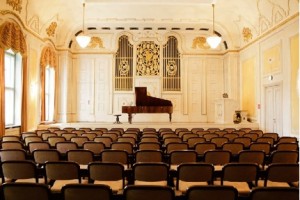Mozart in Salzburg
PhD researcher David Jayasuriya is writing his thesis on the application of Fonte and Monte harmonic schemata in the symphonies of Joseph Haydn. Over the summer vacation he had the opportunity to present some of his work at a prestigious international conference: A highlight of my summer break was to attend and present a paper at the International Mozart Kongress in Salzburg. It was certainly an honour to be invited to this conference, and of course the chance to look around Mozart’s home town was a welcome bonus! The Kongress is organized every two years by the Akademie Mozart Forschung, the research arm of the Mozart Stiftung which complements the editorial functions for the Neue Mozart Ausgabe (the new critical edition of Mozart’s works). The foundation also funds and oversees concerts, festivals and the management of the Mozart library and museums, including the famous Geburtshaus (where Mozart was born) and Wohnhaus (where he later lived). The Mozart Foundation’s impressive main building, located in the historic centre of Salzburg, contains the lovely Wiener Saal, where the conference was held. Our accommodation, generously provided by the Stiftung, consisted of comfortable rooms within the Priesterseminar Salzburg, a superb Baroque seminary attached to the Dreifaltigkeitskirche, and still used for the training of new priests.

The conference itself was very enjoyable. There were many prominent scholars attending from around the world, so being able to hear them present and have the occasional conversation with some of them was extremely stimulating for me. Since this was essentially a bilingual conference, around half the papers were presented in German. This was a particular challenge for some of us overseas delegates, especially since all the papers given by the younger scholars from around Germany and Austria were presented in their native language. Famous speakers at the conference included the American musicologists James Webster, Elaine Sisman and James Hepokoski, among others, while important German scholars included Manfred Hermann Schmid and Hans-Joachim Hinrichsen. An absorbing lecture recital by Robert Levin completed the presentations. Having an interest in empirical matters, I performed a quick calculation and was surprised to find that some 55% of the conference papers related to music theory and analysis, 27% to historical musicology or aesthetics, and the remaining 18% to performance or editorial topics: I would have expected these proportions to be quite different in a general conference on Mozart, and I am fairly certain they would be for a similar conference in this country devoted to a single composer.
My own paper too related to theory and analysis, and its editorial implications for the minuet movement from Mozart’s piano sonata K331. There was an interesting story attached to my preparations, since by a remarkable coincidence, the discovery after some 230 years of the lost autograph for this sonata was announced just a week before my presentation, and its contents had a direct bearing on my study. Moreover, its discoverer was scheduled to speak just after me at the conference! It all worked out well in the end, however, since the autograph actually reinforced my conclusions, and our two presentations complemented each other well. As Danuta Mirka was also presenting at the conference, many delegates there will have been impressed to see two representatives from the University of Southampton music department.
The demands of preparing for my first major conference presentation meant that I had less time than I would have liked to go sight-seeing in Salzburg. In particular, I missed out on the annual Lange Nacht der Museen, when all the museums remain open to visitors well past midnight. Nevertheless, based in the centre of the city, we were within walking distance of the many restaurants, bars and impressive buildings to be savoured in Salzburg; add in the stimulating conference programme, friendly delegates and fine sunny weather, and it all made for a very enjoyable few days. I certainly look forward to another visit in the not too distant future!



